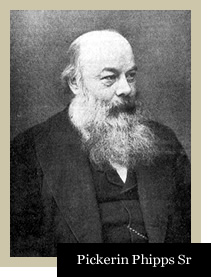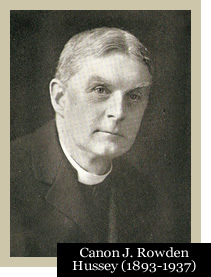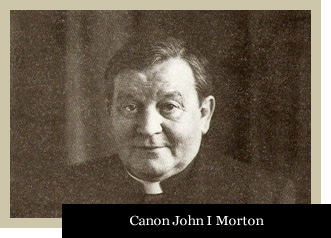| |
| A Proud Past, a Bright Future |
| |
 |
|
The
building was designed by a local architect, Matthew
Henry Holding (1846-1910) in 13th century Gothic
style. It was the gift of the Phipps family in
memory of Pickering Phipps, a local brewer who
had twice been Mayor of Northampton and twice an MP. The
foundation stone was laid on St Matthew's Day in 1891
and the church was dedicated in 1893 on St Matthew's
Day, 21 September.
The Formation of
the Parish and the Building of the Church
In 1868, the Dean of Cork, William Connor Magee,
approached the Prime Minister, Disraeli, with the
request that he might be considered for any appointment
in the Church of England made vacant through the
appointment of a new Dean of St Paul's. The reply turned
down the request but on the reverse sheet offered the
Irishman the See of Peterborough. |
|
|
The new Bishop, already famous as an orator, flung
himself into his work as a diocesan, determined to show
energy and zeal.
One of his aims was to claim back Northampton, then
rapidly growing, for the established church. Since the
Reformation when shoemakers were in the vanguard of
Protestant extremism, Northampton had been strongly
non-conformist. In the nineteenth century the town
showed its radical independent temper by electing an
atheist, Charles Bradlaugh, as MP.
Bishop Magee was determined to reverse these
dangerous tendencies. He created a Church Extension
Committee for Northampton made up of staunch Anglican
gentlemen and businessmen, to raise funds for new
churches in the town. He also recruited widely, zealous
young priests, firm on church principles, to staff his
new infant parishes.
It was thus that a young priest of Tractarian views was
selected in 1889 to begin a mission in the Kingsley Park
area, then in the parish of Kingsthorpe. The Reverend
J R Hussey, who was then Curate of Belgrave in
Leicester, began his work in Northampton in the Junior
Schoolroom in Byron Street. By Easter an iron church had
been erected, dedicated to St Matthew, which housed 72
communicants at its first Easter Day services.
In 1890 the situation of the new congregation was
dramatically changed. When Pickering
Phipps died, he had already indicated that he
would give land for the erection of a church and
vicarage in Phippsville, the new estate then laid out to
match the existing Kingsley Park housing in the poet
streets.
His four daughters and only son decided to carry out
their father's wishes, and to erect a great church in
his memory. Mr Matthew Holding, architect of the
iron church, was selected to design it. Various
relatives of the Phipps family agreed to furnish
the building.
 |
|
The foundation stone was laid on St Matthew's Day 1891,
but not by Bishop Magee, who had recently been
rewarded for his efforts in Peterborough by being made
Archbishop of York. Sadly he was only to enjoy his
elevation for two months, since he died of influenza in
his sixty-fourth year. It was therefore his learned
successor, Bishop Mandell Creighton, who laid the
foundation stone, and returned to consecrate the almost
completed building on St Matthew's Day 1893 and to
institute Fr Hussey as first Vicar. Most of the
fittings which can now be seen - pulpit, iron screens
and organ, followed in 1895. The clock and bells were
installed in 1897-98. By the turn of the century the
building was substantially the same in appearance as it
is today.
Canon Rowden Hussey remained Vicar until 1937. He
had fixed the tradition of the church as firmly Anglican
Catholic, by establishing at the outset a daily
Eucharist celebrated in vestments and from 1898
|
|
substituting a Sung Eucharist for Mattins as the
principal Sunday service. During the long years of his
ministry the area of the parish was filled out by
housing, particularly after the first world war. The
parish became known for its dignified worship and
excellent music. A succession of able curates ensured
that
St Matthew's enjoyed all the activities then
thought to indicate a vigorous church life. The
introduction of incense in 1927 and reservation of the Sacrament from 1930 placed St Matthew's firmly in the
mainstream of Anglo Catholic churchmanship. |
From Father to Son
The patronage of the benefice had been placed in the
hands of the Diocesan Board and it was from then that
Canon Rowden Hussey's priest son Walter
received the invitation to succeed him. Fr Walter
Hussey was unlike his forceful father in manner, but
was in his own way to make a contribution to the life
of
St Matthew's as great as any made by its founding
pastor. As a curate in Kensington he had got to know as
personal friends many who already were, or were to
become, leading figures in the world of literature and
the arts. Fr Hussey was driven by the desire to
build a bridge between the church and modern artists
through adventurous commissions.
When he came to St Matthew's, albeit reluctantly, he was
determined to turn his convictions into action. Though
the liturgy and life of the parish remained largely
unchanged from his father's day, he proceeded throughout
the thirteen years of his incumbency to commission for
St Matthew's, often at extraordinarily low cost, an
outstanding succession of fine works of art.
Moore's sculpture and
Sutherland's painting are the tangible evidences
of this in the church, but musical works by Britten
(Rejoice in the Lamb), Rubbra, Finzi and
Howells were also obtained, and literary
commissions by Auden and Norman Nicholson
were undertaken. Canon Walter Hussey's
pre-eminence in this field of the church and the arts
was recognised by his appointment in 1950 to the Deanery
of Chichester where he was to continue his pioneering
work.
A Succession of
Priests
His successor, Father Charles Mackenzie OBE came
to St Matthew's from Dulwich, with a reputation as an
evangelist, preacher and skilled parish priest. He seems
to have felt that St Matthew's needed urging forward
into the mainstream of contemporary Catholic thinking
and liturgy and sought to make the principal mass one at
which all communicated. He again was in personality and
manner starkly contrasted to his predecessor. His
concern was overwhelmingly for the conversion of the
parish. Sadly, his energetic ministry was brought to a
sudden end when he died on holiday at the age of 47 in
1961.
Fr Philip Turner came in 1962 from a charge in
Crawley, and was in the event to be vicar for only four
years. He threw himself into youth work, and obtained a
nave altar for westward celebrations when the children
of the church school attended. His own great talent and
interest lay however in religious drama and some
spectacular productions took place in the church during
his brief incumbency. It was in fact his desire to write
religious plays which helped to lead him to accept in
1966 a post in religious broadcasting.
The fifth vicar of the parish, Charles Moxon, was
well equipped to uphold the tradition of excellent music
at St Matthew's. He had been a choral scholar at King's
College, Cambridge and Minor Canon and Sacrist
of St
Paul's Cathedral. He secured the services of organists
of the first rank, Stephen Cleobury and
Michael Nicholas, both destined for Cathedral posts,
and maintained the tradition of commissioning musical
works by leading composers for the church. During his
eight years' incumbency, the elderly and inadequate
church room was replaced by the new parish centre
which stands in the grounds. It remains a tremendous
boon to the church's work. Fr Moxon left St
Matthew's in 1975 to become Canon Precentor of Salisbury
Cathedral, where he was to enjoy ten very happy years
before his retirement, sadly terminated within months by
death.
|
 |
|
The Reverend John Morton came to St Matthew's in
1975 from St Andrew's, West Kirby in the Wirrall. Quite
soon after his arrival the Church School in Byron Street
had to close because of the age and unsuitability of the
buildings. Church work in Kingsley began in these and
has suffered in the area since the link was broken
between children and families and the church.
Fr John, who became a Canon of Peterborough in
1982, continued the tradition of
commissioning new works of art, notably the
14
Stations of
the Cross by David Thomas, and
the hanging figure of the
Risen
Christ, the work of the local sculptor,
Malcolm Pollard,
|
|
and designed as a memorial to the ministry
of Dean Hussey. 1993 saw the celebration of
the centenary of the work begun by Rowden
Hussey.
A New Approach
Fr John retired in 1996. He was succeeded the
following year by The Reverend Timothy Pilkington
from St John’s Millbrook in the Diocese of Truro. Fr
Tim set about the comprehensive renewal of worship
at St Matthew’s and the development of a collaborative
approach to ministry in line with contemporary insights.
Under his guidance the PCC expanded the dais at the
front of the nave and introduced a new altar and chairs.
The Lady Chapel was also reordered, and plans were made
for the rewiring and lighting of the church. In 2002
Fr Tim left St Matthew’s to become Team Rector of
Solihull, Birmingham. |
|
|
|
|
 |
|
The
present incumbent, the Reverend Nicholas Setterfield,
became the eighth vicar of St Matthew’s in August 2003.
He had formerly been Rector of Letchworth in the Diocese
of St Albans. Under his tenure the renewal of the
church's worship, ministry and mission is on-going,
together with a concurrent renewal of the church
building and its contents.
A state of the art lighting scheme with touch screen
control has been installed, greatly increasing the
versatility of the environment afford by St Matthew’s
for both worship and concert use. The liturgical
arrangements at the front of the nave have been
completed with the introduction of an ambo,
concelebrants' chairs, and a credence table. Each is made
of maple and walnut to match. The church's forced-air
heating system has been renewed. Toilet and kitchen
facilities at the base of the church tower completed in 2011. |
|
|
In 2009
the parish’s tradition of artistic patronage was renewed
with the unveiling of a life-size bronze
sculpture of
St Matthew by Ian Rank-Broadley at the Patronal
Festival. The sculpture is situated on the south side of
the Quire Screen, and is widely considered a worthy
addition to the church. The commission was the result of
a benefaction given for the purpose by Canon John
Morton, who died in 2002.
St Matthew’s musical fortunes have been reinvigorated in
recent years. Most notably, perhaps, the fine 1895
Walker organ, which had been ailing for many years,
has been comprehensively restored. A professionally
qualified Director of Music once more presides over the
church's music-making, and the choir, now with a top
line of boys and girls, sing to a high standard. The
commissioning of new music has resumed and, in each
case, been made possible by funds given for the purpose.
A new Friends of
St Matthew’s Music has been created to
help sustain the musical life of the parish for the
long-term.
Taking our Parish
Life Forward
Following a Fan the Flame Mission in 2008 there has been
a renewed emphasis on the parish's Ministry of Welcome.
This is borne of a widespread recognition and desire
that we meet the contemporary needs and expectations of
all who come to St Matthew’s for both sacred and secular
purposes.
Creating a Narthex
In particular, plans are currently being formulated to
establish a narthex, or antechamber, to the nave of the
church. It is proposed that this be situated within the
existing structure of the vault supporting the gallery
at the west end. The proposal takes as a precedent the
examples of such an antechamber found in early Christian
churches for use by catechumens and penitents.
There has been a fresh realization that part of our
challenge in developing our Ministry of Welcome is
linked to the existing physical arrangements at the west
end of the church. These are far from ideal and, in a
number of respects, conspire to act as an impediment to
our ministry and mission. Whilst we wish to be
respectful of the fine Victorian environment afforded by
St Matthew’s, we nonetheless wish to make such changes
to this part of the church as will facilitate Christian
hospitality, welcome and nurture. These plans are to be
published in due course.
In Conclusion
St Matthew's is a rather unusual parish church, a place
where uncommon things are possible, and where the
evolution of the church and locality has been
inextricably intertwined. Whilst its worshippers take
justifiable pride in the splendour of the building
created as Pickering Phipps' memorial, and a
living tradition where all is worthily done, they
nonetheless recognize that the People of God exist to
bring the Gospel to that wider community which grew up
in the latter stages of the nineteenth century, where
the tramlines once ended, and which is known throughout
Northampton as Kingsley. This we seek to do in our own
day, near the beginning of the twenty-first century with
its own opportunities, challenges, and rewards.
|
|
|
|









